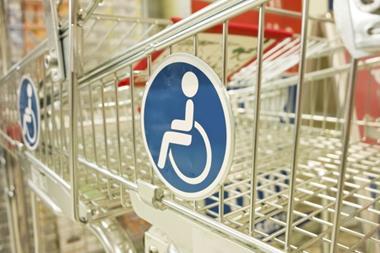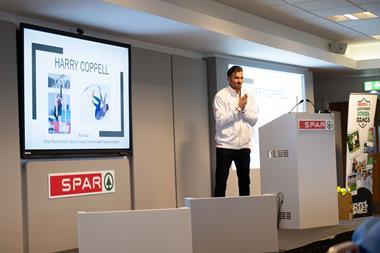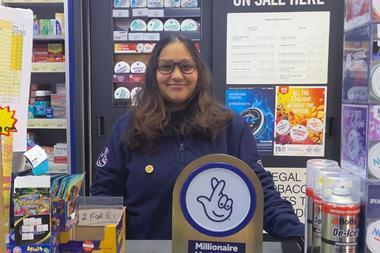People with disabilities are still encountering significant problems when out shopping. C-Store looks at how retailers can right this wrong
At least one in three customers in the UK is disabled or close to someone who has a disability. It’s a significant proportion, yet despite this and the fact that retailers have legal obligations to make sure their stores are accessible (within reason), many people with disabilities say they still encounter physical and emotional barriers when out shopping.
In fact, according to a recent report on the high street by youth disability campaign group Trailblazers, 60% of young disabled people said the layout and design of shops and supermarkets “always or regularly” affected their ability to get around.
More than two-thirds have also been unable to access parts of an establishment owing to broken or faulty equipment, and 40% felt forced to shop online owing to a lack of access.
The data tallies with research from the Department for Work and Pensions (DWP) which shows that disabled people find shopping the most difficult experience for accessibility, followed by going to the cinema, theatre and concerts.
These barriers, both physical and emotional, mean that many high street businesses could effectively be turning away the custom of disabled people - who are collectively thought to have a spending power of around £212bn a year, according to the DWP. The British Disability Forum’s new report, ‘The Walkaway Pound’, found that around £1.8bn per month is being lost to businesses because disabled customers and their families and friends ‘walk away’ from service providers that are not disability friendly. Seven out of 10 disabled people have left a high street shop and a quarter have left a supermarket in the past year, the report adds.
So it’s not just about fairness (although clearly this should be key for any self respecting community retailer) - being accessible also makes good business sense.
According to the Association of Convenience Stores (ACS) which recently published guidance on ‘Welcoming Disabled Customers’ in conjunction with the Business Disability Forum, there are a range of simple things that convenience stores can do to remove physical access barriers. Simple recommendations, such as installing ramps and automatic doors, lowering counters, de-cluttering and/or widening aisles, will help to improve shopping for disabled customers - as well as having a knock on benefit for other customer groups such as the elderly and parents with pushchairs. Managing deliveries, cleaning and shelf stacking are also likely to be easier with wider, less cluttered aisles.
ACS chief executive James Lowman explains: “Convenience stores serve a wide range of customers from all age groups, social demographics and backgrounds, and can play a particularly important role for disabled and elderly customers who value the personalised service and convenient location of a local shop. Making it easier for disabled people means making it easier for everybody.”
One store which is taking its duty to the local community and disabled customers seriously is Lifestyle Express in Winscombe North Somerset. Owned by the wholesale company L&F Jones, and managed by Jeanette Tucker, the store has made a number of meaningful changes as part of a refit last year.
After talking to local people and disability groups prior to the refit, the kerb outside the store was lowered to improve wheelchair and mobility scooter access.
Access to the exterior cashpoint was also improved by sloping the paving stones so that wheelchair users could move up to it with ease.
Inside the store, which is easily accessible through new automatic double sliding doors, aisles were also widened to make it easier to navigate for those with mobility issues.
The changes have already led to a rise in the number of elderly people from the two supported living homes using the store to buy their lunches and dinners each day. “Our nearest competition is a Co-op but its aisles are so narrow that most of the area’s elderly or infirm people prefer to shop with us now,” Jeanette explains.
The store also features what Jeanette fondly refers to as a ‘magic chair’ just inside the door, where elderly or disabled customers can take a seat while she, or another member of the team, carry out a personal shop for them.
“One of our very regular customers who is disabled drives up to the store, parks outside in the disabled bay and beeps her horn. We then come out and help her in, sit her in the magic chair and one of us goes round the store with her shopping list for her while she waits,” she says. “We don’t think of it as an additional service, it’s just what we do, what comes naturally to us as a community-minded store.
“It’s all about being aware of your customers and getting to know them and their needs. Paying attention to every person who comes into the store also helps. Greeting every customer with a simple ‘Hi’ or ‘Hello’ as they walk in is really effective, just making that contact means that you can tell in a matter of seconds if someone is ok or needs a bit more assistance.”
She adds: “If we can see that people who come in are struggling with a basket, we’ll offer them a trolley.
“The layout of the store helps; all of the shelf heights have been lowered so we have good visibility across the shop floor. It means we can see how people are getting on and react to any issues or problems that they have straight away.”
Over in Coventry, the Cheema family have also invested in making their Elm Tree Avenue store in Tile Hill more accessible to disabled shoppers as part of its re-launch earlier this year.
The store is located close to Hereward College, a national Further Education college for young people with disabilities and additional needs.
“Last year the local disability college contacted us to see if we wanted to help them run some workshops,” co-director Paul Cheema says.
“We were keen to participate but the workshops had to be held at our forecourt site as it was easier for some of the students with physical disabilities to access.
“It opened our eyes and got us thinking harder about access at Elm Tree Avenue, which we hadn’t realised wasn’t really good enough. We knew it was something that had to be rectified as part of the refit.”
One of the biggest jobs was to resurface the outside of the store so as to create a gradual slope - rather than a step - up to the main sliding doors. More space was also created outside the store to make it easier for people to park mobility scooters. Inside, aisles were widened to improve access for wheelchairs as well as buggies.
However, one of the biggest changes was the appointment of a customer champion with the specific job of looking after disabled, housebound, and elderly customers.
Customer champion Sally helps shoppers with everything they need, whether it’s home delivery, assisted shopping, a chair to sit on, a glass of water, and much more.
“Appointing a dedicated customer champion means there is someone in the store who has the time to really get to know local customers, to identify needs and respond to them accordingly,” Paul adds.
The changes are already proving popular and Paul says he’s noticed a surge in the number of young people with disabilities shopping in the store as word of its improved access and attentive staff spreads.
Paul’s appointment of a dedicated customer champion tackles another major problem that disabled shoppers encounter when visiting shops: staff attitude and service.
Shockingly, according to the Trailblazers report, nearly half of people with disabilities said that staff attitudes discouraged them from revisiting a shop or supermarket.
“If a shop doesn’t have the resources to make an environment completely accessible, the right staff attitude can minimise physical accessibility issues by offering to assist where necessary,” the report says.
“The law protects disabled people from service providers treating disabled people less favourably than any other customers, but it also makes good business sense to offer a friendly, welcoming service regardless of disability.
“A positive attitude and some basic training can make a huge difference for customers when they are considering a purchase or considering visiting an establishment again.”
According to the Walkaway Pound report, people with non-physical impairments such as memory or behavioural problems are actually more likely to leave a store because of poor disability understanding, than those with physical impairments.
Almost 83% of people with memory impairments have walked away from a store in the last year, followed by people with behavioural impairments and autism at 80.5%, learning difficulties at 79%, a sensory impairment at 78.9%, and a chronic condition at 77.6%.
Clearly, better staff understanding about these complex non-physical or non-visible impairments, and the knowledge to deal with them confidently, could help to reduce these rates.
Trailblazers recommends that at least one member of staff is provided with disability equality training to improve understanding, and encourages the appointment of dedicated ‘champions’ such as Sally.
The Business Disability Forum offers a wide variety of training courses which can help you and your staff increase awareness, skills and confidence when dealing with disability in store. For more info visit www.businessdisabilityforum.org.uk.
Jolanta Lasota, CEO of Ambitious about Autism, explains how retailers should respond to people with the condition.
“One in a hundred people in the UK have autism, so it is crucial that institutions such as local shops have the right levels of understanding and awareness,” he says. “The noise, crowds and bright lights found in large supermarkets and shopping centres can be an intimidating and imposing experience for those with autism, meaning local shops are often the preferred place to go for regular shopping.
“Being attentive, encouraging and patient will go a long way to accommodating those with autism. However, it is important to remember not to be patronising - many people with autism lead independent lives and will only sometimes need a little extra guidance.”
With their convenient locations, inherent flexibility and community credentials, there are surely no outlets better placed than convenience stores to answer the needs of disabled shoppers and help right existing access and attitude wrongs.
The score on the law
Requirements to ensure buildings are accessible to all
All new buildings and all major refurbishments to existing buildings have to meet current building regulations which make provision for disabled people.
These require:
- A step-free entrance to a building
- A lift or suitable ramp between different levels of a building
- Wheelchair-accessible toilets
- All doors to be easily opened and wide enough with good handles that are low enough for wheelchair users.
However, all businesses since 2004 have had a legal duty to make reasonable physical adjustments to ensure their premises are accessible to disabled customers.
According to the law (it is now the Equality Act), the considerations of reasonableness include cost, practicability of making the change, and size of business.
For example, a small store with a large existing step may not have the space to put in a ramp, but the retailer should try to bring products out to the customer or offer home delivery.
Web information
Stores with websites or facebook pages should also consider adding information about their access to help people with disabilities decide where to visit.
According to the Trailblazers report, 70% of young people with disabilities think there is currently inadequate information about access on websites.
Providing an ‘access statement’ makes sense as it would allow disabled people to make informed choices on where to go, it says.
Communicating with disabled customers
Improving access means not just moving physical barriers like steps. It also involves adjusting policies, procedures and methods of communicating.
- Never assume that you know what assistance, if any, a disabled person needs. Always, ask if, and what, they need first.
- Always be patient. Some disabled people need a little more time than usual for everyday tasks such as finding items or paying.
- Speak directly to the disabled person, even if they are accompanied by an interpreter or a companion.
- Use a normal tone of voice.
- Address a disabled person by their first name only if you address everyone with the same familiarity.
- Do not attempt to speak or finish a sentence for the person you are speaking to.
(Source: ACS Welcoming Disabled Customers guide)
Taking payment from blind or partially sighted customers
• Tell the customer clearly how much their basket of items costs and ask how they would like to pay.
• If they give you cash, count the change aloud as you place it in their hand.
• Card machines can be difficult for people with sight problems. Allow the customer to pick it up and hold it close to see the numbers as they enter the PIN.
• Some customers may ask to pay by chip and signature and use a signature stamp provided by their bank. Always accept this if you can.
• Contactless payments can be helpful so always tell them if you offer this.
• Check customers have picked up all their possessions when they leave.
(Source: ACS Welcoming Disabled Customers guide)
Customers who are deaf and hard of hearing
• Look directly at the person you are speaking to.
• Speak clearly and at an even pace, but do not distort or exaggerate your lip movements.
• If you must turn away from the customer, to serve them tobacco for example, stop talking.
(Source: ACS Welcoming Disabled Customers guide)



























1 Readers' comment